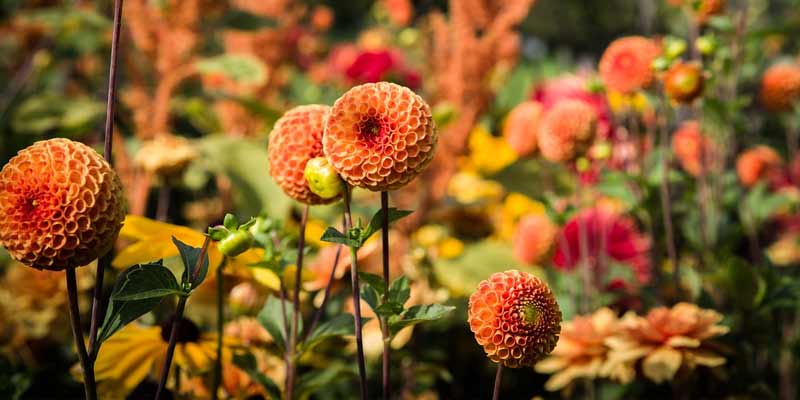Gardeners have long cherished Dahlias as a symbol of beauty and diversity, due to their captivating array of colors and shapes. However, with the shift in seasons bringing plummeting temperatures – a common concern arises among dahlia enthusiasts: will these plants survive frost?
This comprehensive exploration delves into the intricate relationship between dahlias and frost; it examines factors influencing their winter resilience while offering practical tips for ensuring vibrant blooms thrive even in colder climates.
Understanding the Nature of Dahlias
Scientifically identified as Dahlia spp., dahlias are indigenous to the high-altitude regions of Mexico and Central America; their popularity has led them to find a home in gardens worldwide. Their stunning flowers ranging from small, delicate ones, to large intricate blooms captivate viewers with unparalleled beauty: an attraction that transcends geographic boundaries.
However, despite this global acclaim—dahlias lack natural resilience against harsh winter conditions; frost, in particular – poses significant threats to their survival. The high-altitude regions of Mexico and Central America nurture Dahlias, known scientifically as Dahlia spp., tender perennials revered for their stunning flowers—from petite delicacy to grand intricacy—that have found homes in gardens across the globe.
Nevertheless–even amidst widespread admiration–these popular plants lack innate resistance against severe winter conditions; specifically, they falter under the chilling touch of frosty temperatures.
Frost Damage and Dahlia Vulnerability
The sensitivity of dahlias to cold temperatures significantly threatens them with frost. Frost can impact dahlias in various ways: it may blacken or wilt their foliage, make their stems mushy, and discolor blooms. Prolonged exposure to extreme cases of frost could even result in plant death.
Gardeners must actively recognize early signs of frost damage, promptly taking action to avert further harm to their dahlia plants. A thorough comprehension of dahlias’ vulnerabilities to frost sets the foundation for devising effective strategies that safeguard them during colder months.
Factors Influencing Dahlia Frost Tolerance
Understanding the elements that contribute to dahlias’s frost tolerance can guide gardeners in creating a conducive plant environment. Key factors encompass:
1. Dahlia Variety
Varying levels of frost tolerance manifest in different dahlia varieties. Certain demonstrate heightened resilience to colder temperatures, whereas others prove more susceptible. Crucially—when discerning the level of protection necessary—it is imperative to understand your specific dahlia variety’s characteristics.
2. Soil Conditions
Amending the soil with organic matter not only enhances its heat retention ability but also provides root insulation; this proves particularly beneficial in preventing frost damage to dahlias.
Indeed, well-draining conditions play a pivotal role: they prevent waterlogging –a phenomenon that increases susceptibility to frost damage in these plants.
3. Local Climate
Your region’s climate crucially determines frost likelihood and severity. When you understand your area’s average frost dates, along with the length of its frost-free growing season, it aids in planning protective measures appropriately.
Practical Tips for Protecting Dahlias from Frost
1. Monitor Weather Conditions
Ensure you stay informed regarding local weather forecasts, especially during the fall-to-winter transition. This knowledge of anticipated frost dates empowers you to proactively safeguard your dahlias.
2. Mulching
Dahlia plants benefit from the insulation provided when you apply an organic mulch layer, like straw or shredded leaves, around their base. This protective covering not only moderates soil temperature but also averts rapid fluctuations that could potentially damage the roots.
3. Watering
Well-hydrated dahlias generally display increased resilience to frost. Thoroughly watering your dahlias before an expected frost event may prevent dehydration and bolster their capacity for enduring colder temperatures.
4. Covering Plants
Shield your dahlias from frost using protective covers such as burlap, old bed sheets, or frost blankets; secure these covers firmly to prevent wind displacement. The microclimate created by the barriers traps heat and forms a protective shield around the plants.
5. Potted Dahlia Care
Consider relocating your potted dahlias to a sheltered location such as a garage or covered porch during nights that pose an elevated risk of frost as this will afford them more protection.
Potted plants, due to their vulnerability towards temperature extremes, necessitate additional shielding; hence the need for such precautionary measures.
6. Pruning and Digging
Consider, as a more drastic measure: pruning the foliage of dahlias before the initial frost; and simultaneously digging up their tubers for storage. Particularly in regions characterized by exceedingly cold winters—where survival in the ground may not be possible—it is imperative to adopt this approach.
Conclusion
Conclusively, whether dahlias can withstand frost presents a nuanced question contingent on multiple factors. Although not inherently resistant to frost, one can bolster the winter resilience of dahlias through proactive measures.
Understand the specific requirements of your dahlia variety; monitor local weather conditions diligently and implement protective strategies like mulching, covering – even adjusting watering patterns – to guarantee optimal growth for your dahlias in colder climates.
These vibrant blooms, with their beauty and charm, will continue to grace your garden throughout the changing seasons; you must tend them with thoughtful care and attention.



